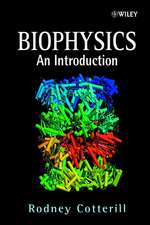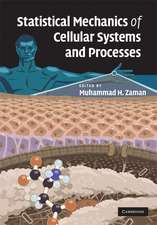Methods in Protein Sequence Analysis: Proceedings of the 7th International Conference, Berlin, July 3–8, 1988
Editat de Brigitte Wittmann-Liebolden Limba Engleză Paperback – 21 noi 2011
Preț: 660.18 lei
Preț vechi: 776.67 lei
-15% Nou
Puncte Express: 990
Preț estimativ în valută:
126.33€ • 130.33$ • 105.42£
126.33€ • 130.33$ • 105.42£
Carte tipărită la comandă
Livrare economică 26 martie-09 aprilie
Preluare comenzi: 021 569.72.76
Specificații
ISBN-13: 9783642738364
ISBN-10: 3642738362
Pagini: 616
Ilustrații: XXXV, 575 p.
Dimensiuni: 170 x 244 x 32 mm
Greutate: 0.97 kg
Ediția:Softcover reprint of the original 1st ed. 1989
Editura: Springer Berlin, Heidelberg
Colecția Springer
Locul publicării:Berlin, Heidelberg, Germany
ISBN-10: 3642738362
Pagini: 616
Ilustrații: XXXV, 575 p.
Dimensiuni: 170 x 244 x 32 mm
Greutate: 0.97 kg
Ediția:Softcover reprint of the original 1st ed. 1989
Editura: Springer Berlin, Heidelberg
Colecția Springer
Locul publicării:Berlin, Heidelberg, Germany
Public țintă
ResearchDescriere
"Methods in Protein Sequence Analysis - 1988" - contains selected contributions on modern protein- analytical techniques as presented by speakers at the Seventh International Conference on "Methods in Protein Sequence Analysis", held from July 3rd to July 8th, 1988 in Berlin. The book contains information on new methodologies for sensitive amino acid analysis, N- and C-terminal sequence analysis, and protein and peptide purification. In addition recent mass spectrometric approaches are described, as an alter native technique to the common stepwise degradative sequence analysis of polypeptides by the Edman method. The book presents new possibilities in the design of sequencers and sophisticated equipment for the structural analysis of peptides and proteins. It describes practical approaches for the investigation of protein domains and protein complexes, and contains review chapters on the crystallization of cell organelles as well as on recent theoretical aspects of protein folding mechanisms. The nature of protein folding is not yet understood, but further advances in this area would greatly enhance our present knowledge of protein structure and function. Further, the book gives examples of the application of gene technology to protein characterization and to the design of new proteins. This enables new studies on the structure and function of proteins to be made, and opens up efficient approaches to the design of drugs.
Cuprins
1 A Critical Evaluation of Sensitive Amino Acid Analysis.- 1.1 Detection Limits in Amino Acid Analysis: An Overview.- 1.2 Amino Acid Analysis at High Sensitivity: A Critical Review of the Communications.- 1.3 A Comparison of 9-Fluorenylmethylchloroformate (FMOC-Cl) Amino Acid Analysis with Ninhydrin and Phenylthiocarbamyl (PTC) Chemistries.- 1.4 Localization of Endogenous Phosphoserine Residues in the Primary Structure of Proteins.- 1.5 Quantitative N-terminal Analysis of Polypeptides.- 2 New Approaches for the Chemistry of the Edman Degradation.- 2.1 Study on New Edman-type Reagents.- 2.2 Protein Microsequence Analysis with Dansylamino-PITC.- 2.3 Manual Gas Phase Isothiocyanate Degradation.- 3 New Instrumentation in Sequence Analysis and Synthesis of Biopolymers.- 3.1 A Second Generation Solid-phase Protein Sequencer: The Prosequencer™.- 3.2 Development of Membrane Supports for the Solid-phase Sequence Analysis of Proteins and Peptides.- 3.3 Accelerated High Sensitivity Sequence Analysis of Proteins and Peptides Immobilized on Chemically-modified Glass Fiber Discs.- 3.4 A New Modular Sequencer.- 3.5 An Improved Injection System for On-line High Sensitivity Phenylthiohydantoin Amino Acid Analysis.- 3.6 Design and Performance Features of a Simplified Protein Sequencer with an On-Board Isocratic HPLC System.- 3.7 New Aspects in Isocratic HPLC Separation of Phenylthiohydantoin Amino Acids Through the Application of Ionic Detergents.- 3.8 A Procedure for the Manual Precyclization of Fiber Glass Filters used in the ABI 470A Protein Sequencer.- 4 C-terminal Sequence Analysis: Alternative Techniques to the Stepwise Edman Degradation.- 4.1 The Long Search for a Viable Method of C-terminal Sequencing.- 4.2 C-terminal Sequencing: A New Look at the Schlack-Kumpf Thiocyanate Degradation Procedure.- 4.3 Carboxyl-terminal Sequence Analysis of Proteins and Peptides by Chemical Methods.- 4.4 Primary Structure Determination of Proteins by Using a Set of Directly Purified C-terminal Peptides.- 4.5 Immobilized Anhydrotrypsin as a Specific Affinity Adsorbent for Polypeptides Containing Arginyl, Lysyl, or S-Aminoethylcysteinyl Residues at the C-termini.- 4.6 Obtaining Primary Sequence Information from the Carboxy Terminal End of Polypeptides.- 4.7 Reinvestigation on BNPS-Skatole Cleavage of Tryptophan Polypeptides and the C-Terminal Sequencing of the Cleavage Fragments.- 5 New Instrumentation and Approaches in Mass Spectrometry of Biopolymers.- 5.1 Advances in Peptide and Protein Sequencing by High Performance Tandem Mass Spectrometry.- 5.2 Protein Sequence Analysis by Tandem Quadrupole Fourier Transform Mass Spectrometry.- 5.3 Strategy for the Use of Plasma Desorption Mass Spectrometry in Protein Sequence Analysis.- 5.4 Peptide Analysis by Time-of-flight Secondary Ion Mass Spectrometry.- 5.5 Analysis of Post-translational Modification and Processing by High Mass FAB Mass Spectrometry.- 6 HPLC Purification of Proteins and Peptides for Microsequence Analysis; Recovery of Proteins from Gels.- 6.1 NH2-Terminal and Internal Microsequencing of Proteins Electroblotted on Inert Membranes.- 6.2 Initial and Repetitive Yields from Proteins Blotted on PVDF Membranes.- 6.3 Evaluation of Siliconized Glass Fiber Membrane for Protein Chemical Analysis.- 6.4 Rapid Peptide Mapping and Protein Analysis by HPLC.- 6.5 Application of Microbore HPLC for Purifying Proteins and Peptides for Microsequence Analysis.- 6.6 Effect of Bead Size on the Analysis of Proteins and Peptides by High Pressure Liquid Chromatography.- 6.7 The Influence of SDS on Micropreparative Peptide Separations on Reversed Phase Columns.- 6.8 Micro-manipulation and Micro-sequencing of Proteins.- 6.9 Preparative Separation of Bioactive Protein on High Performance Hydrophobic Interaction Chromatography.- 6.10 Cuttelfish Protamines: Amino-acid Sequences of Three Distinct Variants.- 6.11 Direct Characterization of Proteins and Peptides in HPLC by Photodiode Array UV-VIS Detection: A New Approach in the Detection and Characterization of Polypeptides.- 7 New Strategies of Protein and Peptide Characterization.- 7.1 A Fluorescent Labelling Procedure to Facilitate Protein Isolation for Rapid Structural Analysis on a Microscale: Application to Analysis of Post-translational Processing of Newcastle Disease Virus Proteins.- 7.2 Specific Enzymatic Cleavage at Cystine/Cysteine Residues. The Use of ASP-N Endoproteinase.- 7.3 Limited Proteolysis as a Tool to Detect Structure and Dynamic Features of Globular Proteins: Studies on Thermolysin.- 7.4 Biochemical Characterization of Posttranslational Processing Enzymes.- 7.5 Characterization of Gonadotropin Hormone-Releasing Hormone Analogs.- 7.6 Brain Nicotinic Acetylcholine Receptors: A Gene Family.- 7.7 N?-Acetylation of Eukaryotic Proteins: Purification and Characterization of Yeast N?-Acetyltransferase and Acetylcoenzyme A Hydrolase.- 8 Organization of an International Protein DATA Base; Evaluation of Software; Computer-assisted Search and Comparison of Sequences.- 8.1 International Cooperation Among Protein Sequence Data Banks.- 8.2 Current Status of Protein Data Banks.- 8.3 Database Lysis: Computer-assisted Investigation of Cleavage Sites in Proteins.- 9 Protein Folding and Three-dimensional Structure Elucidation of Proteins: Theoretical and Practical Approaches.- 9.1 Preferred Residue Interactions in Protein Subunit and Domain Interfaces.- 9.2 Protein Structural Elements and Folding.- 9.3 Membrane-controlled Folding Mechanism of Hepatitis B Surface Antigen of Human, Woodchuck, Ground Squirrel and Duck.- 9.4 The Three-dimensional Structure of the Pore-forming Fragment of Colicin A.- 9.5 Structural Studies on Crystals of Ribosomal Particles.- 10 Recombinant DNA-Technology as Tool for Protein Sequence and Activity Relationship.- 10.1 Cystatins and Cystatin-like Domains of Multifunctional Proteins: Solid-phase Microsequencing as a Tool to Study Structure-Function Relationships of Protein Inhibitors.- 10.2 New Inhibitory Properties of Eglin C after Specific Mutagenesis.- 10.3 Immuno-chemical Recognition of Synthetic Peptides Based on the Sequence and Three-dimensional Structure of Human Renin: An Immuno-control of Renin Activity.- 10.4 Sequence Directed Design of Recognition Peptides.- 11 Domain Substructure Analysis and Interaction of Biomolecules.- 11.1 The Domain Structures of the E2 Components of the Pyruvate Dehydrogenase Multienzyme Complexes from Bacillusstearothermophilus and Saccharomycescerevisiae.- 11.2 The Identification and Significance of Substructural Domains.- 11.3 Identification of Murine Nuclear Proteins that Bind to the Octamer Control Sequence of Immunoglobulin Genes using 5’-Amino-Oligonucleotides.- 11.4 Structure and Functional Domains of Human Apolipoprotein B-100: A Strategy to Elucidate the Structure Information of a Large Protein.- 12 Immunological Recognition and Strategies.- 12.1 Synthesis of Immunotoxins Using a Temperature Controlled Cross-linking Agent.- 12.2 The Extracellular Functional Sites on the ?-Subunit of Acetylcholine Receptor and of the Receptor-Binding Sites on ?-Neurotoxin.- 12.3 The Antigenic Structure of Lysozyme as Detected by T-cells.- 13 Analysis of Membrane Proteins.- 13.1 Proteinchemical Methods in Use with Complex Membrane Enzymes (Cytochrome C Oxidase).- 13.2 Rhodopsin and G-Protein Linked Receptors.- 13.3 The Cholinergic Binding Site: From Sequence to Function.- 13.4 Characterization of Proteins Involved in Mammalian Mitosis.- Concluding Remarks And Outlook.- Protein Chemistry Renascent.- Protein Chemistry and the Biotechnology of the Future.- Contributors Index.














